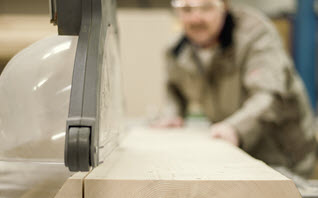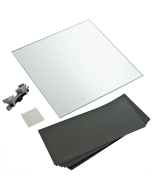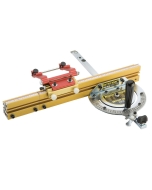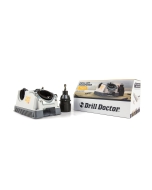Tool Maintenance Made Easy

If you're like most woodworkers, you've invested a lot in your tool collection, both financially and in the time you've spent choosing, acquiring and setting up the tools that make up your shop. But how much time have you devoted to taking good care of them? With a bit of information, a modest investment in equipment and supplies, and a little time, you can keep your tools running at peak performance year-round.
What Tool Maintenance can do for Your Shop
At the most fundamental level, woodshop tool maintenance simply means keeping your tools operating as well as they did when you took them out of the box. That's a minimum requirement for running a safe, successful shop. But a good tool maintenance regimen can take you even further. Taking a few extra steps in caring for work surfaces, cutting edges, alignment mechanisms and moving parts can work wonders for the performance of your tools. Add in a few affordable power tool upgrades and you can improve the performance of your woodworking machinery beyond like-new condition. Below, we'll show you how easy it can be to go beyond the basics in keeping the tools in your shop sharp, true, clean and running smooth.
Keeping Your Blades Sharp
Most of the tools in a woodshop are designed to do one thing - cut wood. Naturally, one of the most important aspects of tool maintenance is keeping cutting edges as sharp as possible. In fact, your safety and the quality of your woodworking depends on doing a good job here. From sharpening systems for hand tools to simply outfitting your tools with the best router bits and saw blades, there's a lot that you can do to give yourself the "edge" when it comes to cutting and machining parts.
Circular Saw Blades
Most woodworkers who've been at it for a while shop for bits and blades from manufacturers they trust. Circular saw blades from Freud and Forrest are manufactured from the highest quality carbide and tool steel, and designed to keep an edge through continued use. These manufacturers also produce blades designed to stand up to applications that can be very rough on cutting edges, like cutting man-made substrates and laminates. There's really no alternative to paying a professional sharpening service to put a new edge on a circular saw blade - it's actually cheaper in the long run to spend a little extra on blades that can go a long time between sharpening.
Router Bits
Router bits usually need to be replaced when they become very dull or damaged. That's a good reason to stay away from discount bits and bit sets. Rockler's line of router bits, and those from reputable manufacturers like Amana and Freud, are manufactured using the highest quality carbide and tool steel, meaning that they can be kept in service for years without needing to be replaced.
Band Saw Blades
Band saw blades are another cutting tool that are almost always replaced rather than sharpened. Make replacing your band saw blade with a premium blade a standard part of your maintenance schedule. You'll be money and time ahead in the long run.
Drill bits
What about drill bits? Once again, buying the best set of bits you can afford to begin with is the best solution for a dull drill bit problem. A good set of forstner bits, if used correctly, will stand up to a lot of use before they lose their edge. But even the best drill bits get dull after a certain amount of sustained use, and a dull drill bit can cause ragged hole-edges and burning. If you're the type who likes to speed through drilling operations, leaving nothing but crisp, clean-edged holes in your wake, a sharpening system that works for most popular drill bit types, like the drill Doctor, would be a sound tool maintenance investment.
Hand Tools
Hand tools - planes, chisels, gouges and the like - absolutely require an adequate sharpening system. A good sharpening system for the delicate cutting edges of fine hand tools will allow you to do two things: grind the tool to the correct shape, and hone it to a near-perfect edge. Perfectly acceptable results can be achieved using a grinder outfitted with a cool-running white aluminum oxide grinding wheel and a fairly simple honing system, like Rockler's Plate Glass Sharpening System.
If hand tools figure prominently in your woodworking, consider investing in a more advanced sharpening system. The Delta Sharpening Station is an excellent all-in-one sharpening system at an affordable price. And if you want the top of the line, it doesn't get any better than the Tormek Sharpening System.
Sharpening hand tools is really an art form in itself, and it would be impossible to do it justice here. That's why we'd like to recommend another precision sharpening tool: a sharpening book. Both Leonard Lee's Complete Guide to Sharpening and Taunton's Complete Illustrated Guide to Sharpening offer in-depth information that can bump your sharpening techniques up to the expert level.
Keeping Your Tools In Alignment
Keeping tools in proper alignment is of paramount importance to the performance and accuracy of woodworking tools and equipment. Once set up and adjusted, quality woodworking machinery generally stays in alignment for a long period. But vibration and continued use will eventually cause even the best machinery to go out of adjustment. This is an area where a book or DVD dedicated to a specific power tool can really help out. Many contain detailed information both on how to use the tool and on how to keep in top form. While we can't cover the subject of adjustment and alignment in detail for every woodworking machine, we can offer a few suggestions for two of the most used tools in your shop.
Table Saw Alignment
For the centerpiece of your shop, "your table saw" it also helps to have a tool to help keep things lined up. For a table saw to produce smooth cuts, and to avoid safety risks, the blade must be aligned to run parallel with the miter slot and fence. The Master Plate With Super Bar table saw calibration system will help you diagnose alignment problems and keep your table saw blade running perfectly true.
Upgrading your table saw's fence and miter gauge is one of the easiest ways to improve its performance. Many contractor grade saws are outfitted with excellent basic components - the bed and the motor are fine - but sometimes an exceptional quality fence and miter gauge aren't part of the bargain. Adding an accurate fence system and a precision miter gauge will greatly increase the accuracy and reliability of many table saws.
Band Saw Tracking & Alignment
Your band saw's ability to make a true cut without wander can be improved by an upgrade to it's blade guiding system. Simply adding a set of ceramic guide blocks will significantly improve the tracking performance of most band saws. And adding a Carter Band Saw Guide can transform an ordinary band saw into a professional class machine.
Keeping Your Tools Clean & Smooth
In woodworking, friction is the enemy, and that makes keeping your tools clean and free of pitch and resin buildup extremely important. While your first line of defense against woodworking debris will always be an adequate dust collection system, you'll still need to keep power tool surfaces that come in contact with the wood clean and properly lubricated.
Keeping Saw Blades Clean
Especially when you are sawing pitchy softwoods, it doesn't take long for your table saw blade to get loaded up with a coat of pitch and resin. The sticky residue causes drag, vibration, and a buildup of extra heat, all of which affect not only your woodworking experience, but also the quality of the cut. A few squirts of Pitch and Resin Remover and a quick polish at blade-change time will keep your circular saw blades clean and smooth.
Cleaning & Conditioning Router Bits
Your router bits are another likely candidate for periodic cleaning. There is often only a small amount of clearance between a router bit's cutting edge and its body, where resin buildup can significantly add to the friction created during the cut. You can use the same cleaner that you use for your saw blades to keep your router bits bright and shiny. And for lasting protection, pick up the router bit and saw blade cleaning kit. The kit includes both a generous supply of pitch and resin remover and a lubricant specially designed to condition and protect router bit pilot bearings.
Stationary Tool Surfaces
The surfaces of your table saw, jointer, band saw and planer are designed to support the workpiece and allow it to pass smoothly through the cut. To keep them performing up to par, these surfaces need to be kept clean and free of corrosion. And to enhance their performance, most woodworking experts advocate a light lubrication. The Boesheild 3-part tool care kit includes everything you need to restore the work surfaces of your tools to their original stain and corrosion-free condition, remove pitch and resin, and lubricate them with a lubricant designed especially for power tool care.
Keeping Your Tools Running Smooth
Here you have a great opportunity to improve your woodworking and help your tools age gracefully at the same time. Power tools, at least good ones - are designed to stand up to heavy use, but if you want them to stay that way for a lifetime, you have to take care of their mechanical parts. To protect your investment, make sure that all of your tools and machinery are kept in good working order and properly lubricated. Along with the basic considerations, there are a few mechanical upgrades that, in many cases, will improve a power tool's performance beyond like-new condition.
Lubricating Bearings & Moving Parts
The lubricant you use to keep your tools' moving part and bearings in top condition should be designed for the job. Bearing lubricant penetrates bearings to protect and seal internal parts, reduce heat buildup and extend the life of the tool. For long, trouble-free service from all of your stationary and handheld power tools, lubricate all bearings and moving parts on a regular basis. You can also improve the performance of your band saw, scroll saw and coping saw blades with a blade lubricant stick. Made with a special blend of wax and oils, the lubricant stick extends blade life and helps prevent clogging.
Mechanical Upgrades for Power Tools
Worn out drive belts cause increased vibration and slippage - not to mention the tendency they have to break at the most inopportune times. When it's time to change belts, you have an opportunity to increase the performance of most tools by upgrading to a power twist link belt.The Power Twist belt is made up of interlocking segments of tough polyurethane elastomer and multiple plies of polyester fabric. The unique feature of the belt is its removable link design, which allows the belt's length to be adjusted to provide optimal tension for a variety of tools. The Power Twist also hold its shape far better than standard drive belts The result is greatly increased belt life and reduced tool vibration of up to 35%.
Band saw tires are one of the most neglected mechanical components in woodworking. The usual rubber band saw tires are often left on long after they've lost flexibility and begun to crack. The cost in tool performance is increased vibration, reduced blade life and poor tracking. Unlike rubber tires, urethane band saw tires never dry out, meaning that you'll retain the exceptional, vibration-free blade tracking of a new tire for a long time. The tires retain their shape and fit tight to the wheel. You don't need to glue them down, so if they ever do wear out, changing them is quick and easy.
While you're servicing your band saw, check to see if it is equipped with an integral wheel brush. If it isn't, do yourself a favor and get an add-on wheel brush to keep your new band saw tires free of the dust and debris that can have a serious effect on blade performance. For the money, a wheel brush is one of the most cost effective tool improvements you can make.
Anything you can do to limit vibration is worth the effort. Vibration shows up in poor tool performance and less than desirable cut surfaces - and it takes its toll on moving parts and bearings. Adding a blade stabilizer to tools that use circular saw blades is one more step in the right direction. Blade stabilizers, which can be used on most stationary tools that use 7' and larger circular blades, reduce blade rim vibration and increase blade life while limiting the level of vibration that would otherwise be transmitted to your saw's arbor bearings.
Staying On Top Of Tool Maintenance
In the long run, it's a lot easier to develop a tool maintenance program and stick with it than it is to rescue and replace tools that have been neglected. Establish a maintenance schedule and stick with it.
Keep the inspiration coming!
Subscribe to our newsletter for more woodworking tips and tricks


